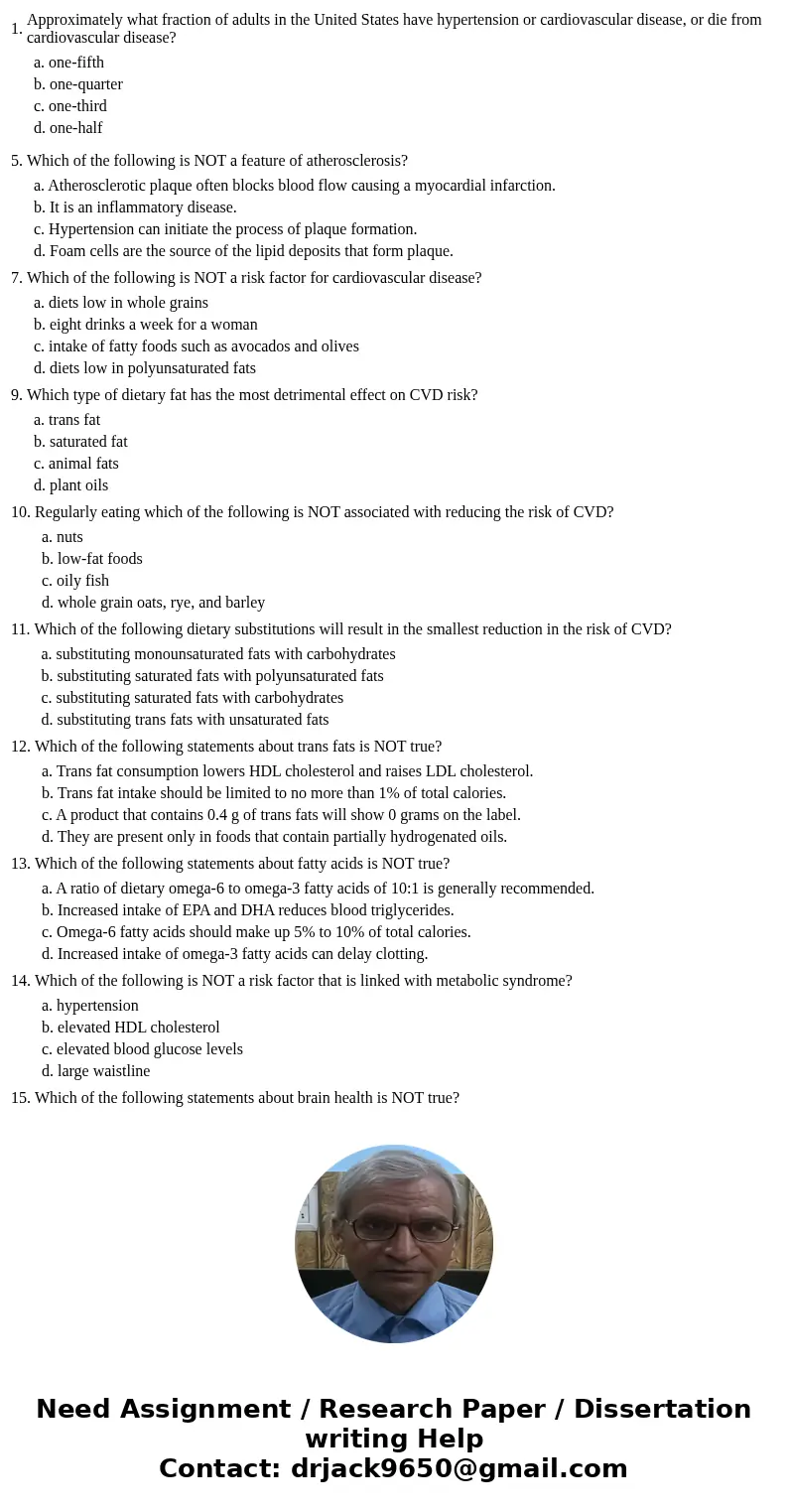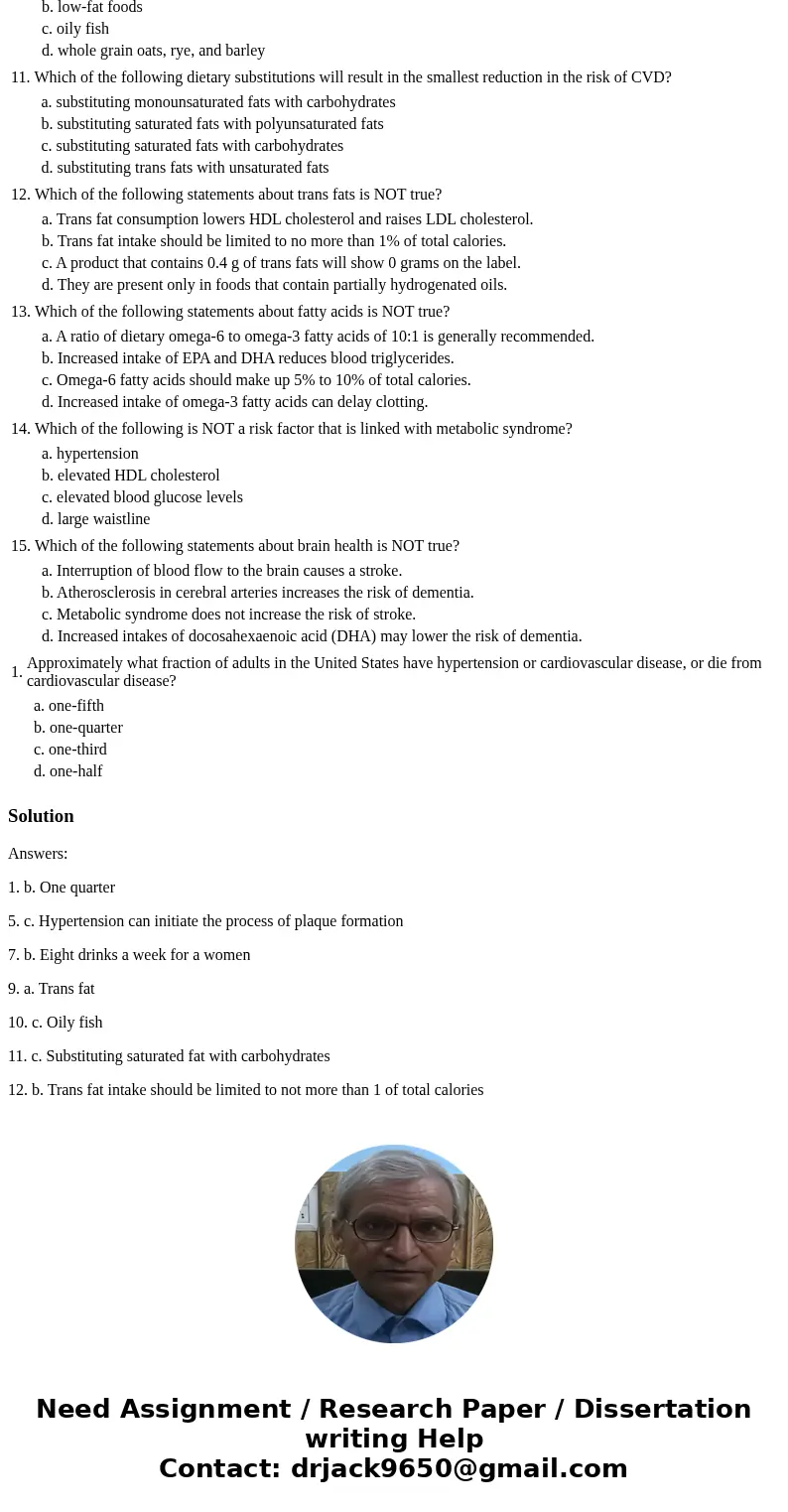| 1. | Approximately what fraction of adults in the United States have hypertension or cardiovascular disease, or die from cardiovascular disease? |
| | a. one-fifth | | b. one-quarter | | c. one-third | | d. one-half | |
| 5. | Which of the following is NOT a feature of atherosclerosis? |
| | a. Atherosclerotic plaque often blocks blood flow causing a myocardial infarction. | | b. It is an inflammatory disease. | | c. Hypertension can initiate the process of plaque formation. | | d. Foam cells are the source of the lipid deposits that form plaque. | |
| 7. | Which of the following is NOT a risk factor for cardiovascular disease? |
| | a. diets low in whole grains | | b. eight drinks a week for a woman | | c. intake of fatty foods such as avocados and olives | | d. diets low in polyunsaturated fats | |
| 9. | Which type of dietary fat has the most detrimental effect on CVD risk? |
| | a. trans fat | | b. saturated fat | | c. animal fats | | d. plant oils | |
| 10. | Regularly eating which of the following is NOT associated with reducing the risk of CVD? |
| | a. nuts | | b. low-fat foods | | c. oily fish | | d. whole grain oats, rye, and barley | |
| 11. | Which of the following dietary substitutions will result in the smallest reduction in the risk of CVD? |
| | a. substituting monounsaturated fats with carbohydrates | | b. substituting saturated fats with polyunsaturated fats | | c. substituting saturated fats with carbohydrates | | d. substituting trans fats with unsaturated fats | |
| 12. | Which of the following statements about trans fats is NOT true? |
| | a. Trans fat consumption lowers HDL cholesterol and raises LDL cholesterol. | | b. Trans fat intake should be limited to no more than 1% of total calories. | | c. A product that contains 0.4 g of trans fats will show 0 grams on the label. | | d. They are present only in foods that contain partially hydrogenated oils. | |
| 13. | Which of the following statements about fatty acids is NOT true? |
| | a. A ratio of dietary omega-6 to omega-3 fatty acids of 10:1 is generally recommended. | | b. Increased intake of EPA and DHA reduces blood triglycerides. | | c. Omega-6 fatty acids should make up 5% to 10% of total calories. | | d. Increased intake of omega-3 fatty acids can delay clotting. | |
| 14. | Which of the following is NOT a risk factor that is linked with metabolic syndrome? |
| | a. hypertension | | b. elevated HDL cholesterol | | c. elevated blood glucose levels | | d. large waistline | |
| 15. | Which of the following statements about brain health is NOT true? |
| | a. Interruption of blood flow to the brain causes a stroke. | | b. Atherosclerosis in cerebral arteries increases the risk of dementia. | | c. Metabolic syndrome does not increase the risk of stroke. | | d. Increased intakes of docosahexaenoic acid (DHA) may lower the risk of dementia. | |
| 1. | Approximately what fraction of adults in the United States have hypertension or cardiovascular disease, or die from cardiovascular disease? |
| | a. one-fifth | | b. one-quarter | | c. one-third | | d. one-half | |
Answers:
1. b. One quarter
5. c. Hypertension can initiate the process of plaque formation
7. b. Eight drinks a week for a women
9. a. Trans fat
10. c. Oily fish
11. c. Substituting saturated fat with carbohydrates
12. b. Trans fat intake should be limited to not more than 1 of total calories


 Homework Sourse
Homework Sourse